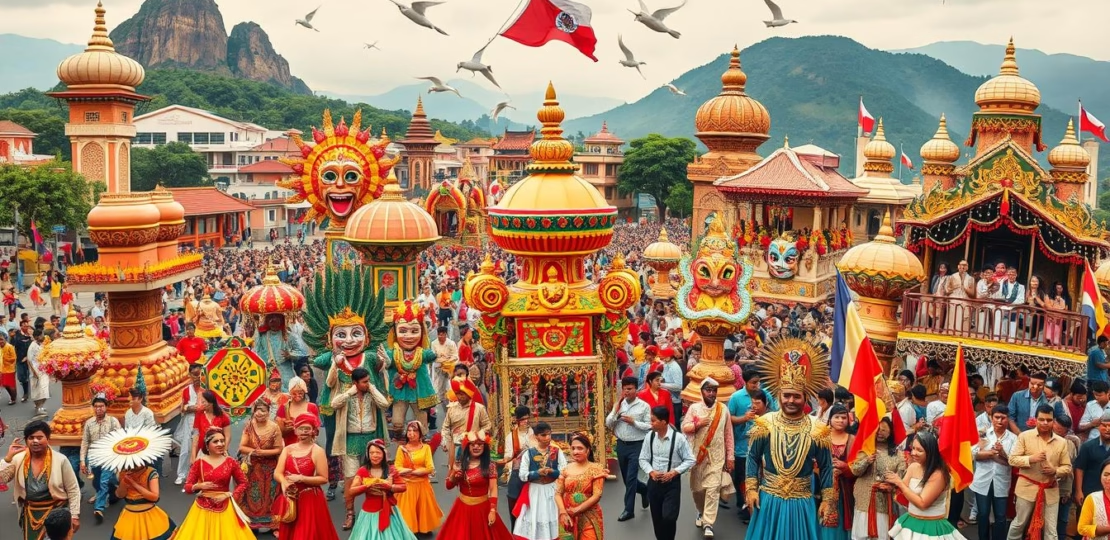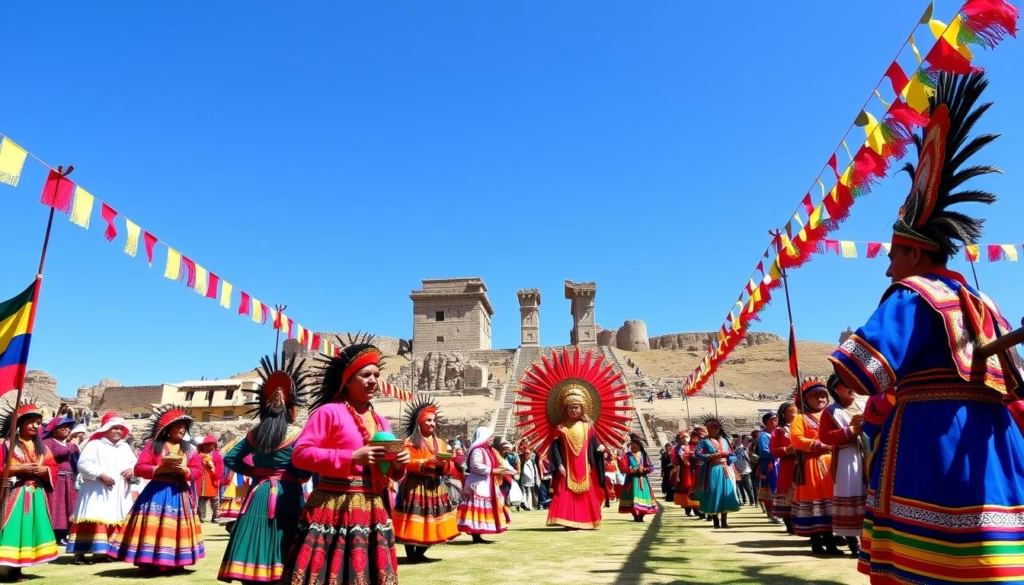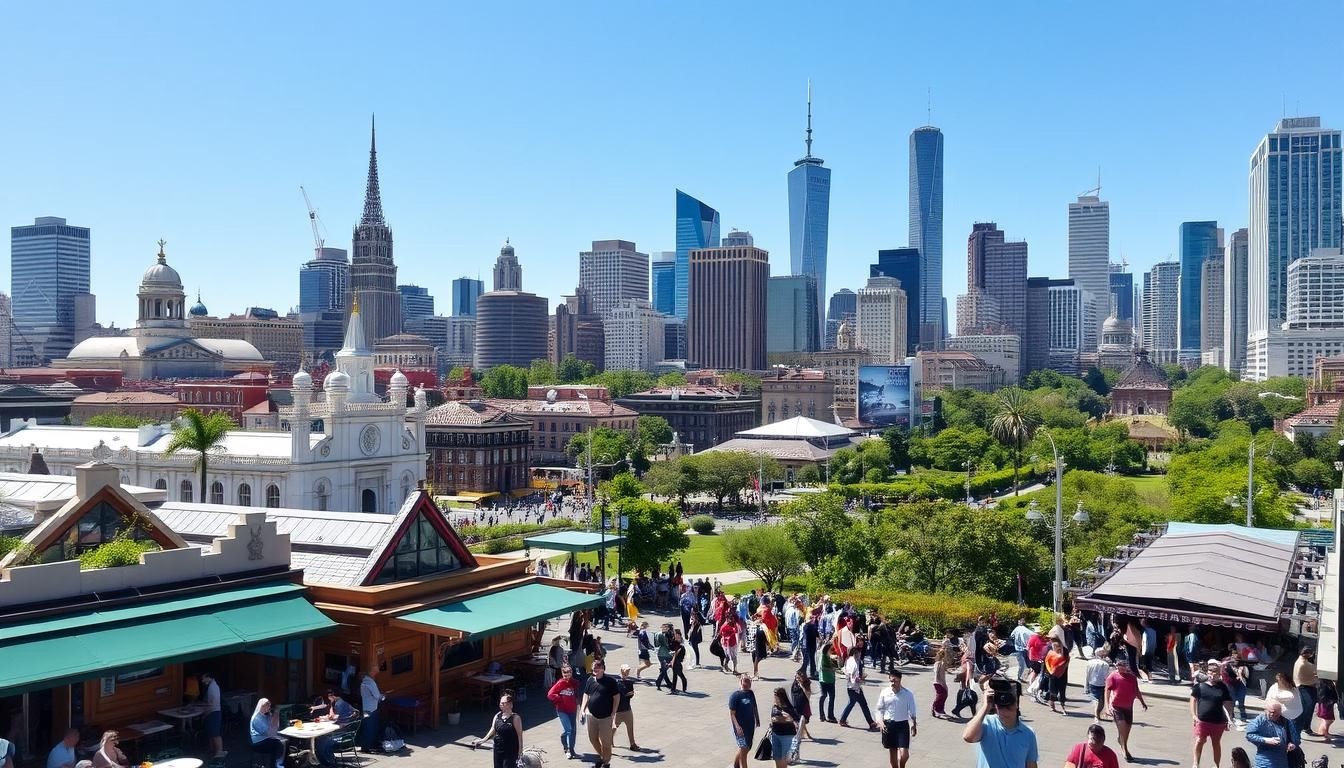Cultural Festivals Around the World: A Guide to the Most Colorful
January 4, 2025 | by m33559844@gmail.com

Cultural Festivals Around the World
Ever thought about how cultural festivals around the world celebrate unique traditions? They create unforgettable experiences for both locals and travelers. Events like India’s Holi and Brazil’s Carnival are more than just parties. They are key moments that show who we are and bring us together.
Festivals are important for sharing cultures. They engage millions in a mix of art, history, and spirituality. By joining in, people get to learn about different customs and help keep traditions alive.
Key Takeaways
- Cultural festivals bolster community spirit and showcase local traditions.
- Holi Festival of Colors occurs annually on the last full moon day of Phalunga, usually in March or late February1.
- Carnival in Rio de Janeiro attracts around two million revelers per day, making it the world’s largest Carnival festival2.
- The Naadam Festival in Mongolia takes place from July 10-131.
- Timket Festival in Ethiopia spans two days, marked by a sacred procession1.
If you’re ready to kickstart your travel journey with ease and exclusive savings, book your first trip now! Visit Trip.com using this special promotion link and register to reserve tickets, accommodation, and more. Don’t miss out on these incredible travel deals tailored for first-time travelers—start planning today!
Introduction to Global Cultural Celebrations
Cultural celebrations are lively ways to show off heritage every year. They highlight local traditions and bring communities together. For example, Holi, celebrated on March 28 and 29, marks important seasonal changes and cultural stories. It symbolizes new beginnings and victory over evil3.
These festivals are stages for diverse cultural elements like music, dance, food, and art. They weave together to create a colorful world of multicultural celebrations.
Many annual cultural events boost local economies by promoting crafts and drawing in tourists. These festivals help communities come together through shared meals and rituals. They also strengthen cultural identity and keep traditions alive4.
Oktoberfest in Munich, for instance, draws millions from September 10 to October 3, 2021. It’s a place for cultural sharing and connection3.
Seasonal festivals connect us with nature’s rhythms and foster community spirit. Events like the Yee Peng Lantern Festival on November 19, 2021, let people release lanterns. This act symbolizes letting go and connects tradition with personal reflection3.
These celebrations not only keep identities alive but also bring people together. They celebrate the rich tapestry of diverse heritages.
Cultural Festivals Around the World
Cultural festivals are key in our society. They are lively events that keep heritage alive and bring people together. These festivals offer a chance to dive into different cultures, learning about the world in a fun way. They are special times to celebrate our differences and learn from each other.
The Importance of Cultural Festivals
Cultural festivals are more than just fun. For example, Diwali in India is a time of rich traditions for many religions5. In Mexico, Dia de los Muertos honors the spirits of ancestors5. These events teach us about local customs and help keep them alive in today’s world.
How Festivals Foster Community Spirit
Festivals unite people, building a strong sense of community. In Japan, the Obon Festival is a time for families to come together5. The Edinburgh Festival Fringe brings people from all over, celebrating diversity6. These events strengthen our bonds and show the value of coming together.
| Festival | Location | Date | Duration |
|---|---|---|---|
| Diwali | India | Mid-October to Mid-November | Varies |
| Dia de los Muertos | Mexico | October 31 – November 2 | 3 days |
| Songkran | Thailand | Mid-April | Long weekend |
| Oktoberfest | Munich, Germany | September | 16 days |
| Mardi Gras | New Orleans, USA | Pre-Lent | Varies |
| Obon Festival | Japan | August | 3 days |
| Edinburgh Festival Fringe | Scotland | August | 1 month |
Holi Festival of Colors in India
The Holi Festival, also known as the Festival of Colors, is a big deal in India. It marks the start of spring and the win of good over evil. People from all walks of life come together, putting aside differences, to celebrate with joy and love.
Significance of Holi
This festival is all about the love story of Radha and Krishna, showing the power of goodness. It’s celebrated by Hindus, Jains, and others every year on Phalguna Purnima, usually in February or March78. It’s a time for unity, forgiveness, and new beginnings.
Celebrations and Traditions
Holi festivities go on for two days, with different activities in each place. The fun begins with Holika Dahan, a bonfire that shows good winning over evil8. On the main day, people enjoy:
- Playing with colored powders and water
- Dancing to lively tunes
- Welcoming friends and family
- Sharing sweet treats like gujiya and thandai
Playing with colors makes Holi unforgettable, refreshing personal ties and community bonds7. Each region in India adds its own twist, making the festival even more special.
Naadam Festival in Mongolia
The Naadam Festival is a big celebration of Mongolian traditions. It attracts both locals and travelers. The festival takes place in July and features exciting games like wrestling, horse racing, and archery. It also includes knucklebone shooting, making it a unique event.
Overview of the Traditions
The Naadam Festival started in 1922, after the Mongolian People’s Revolution of 1921. It happens every year on July 11 and 12. The festival is celebrated in 21 provinces and 330 soums across Mongolia.
Local celebrations are held on different dates to encourage competition. The festival was recognized by UNESCO in 2010. It’s seen as a key part of humanity’s cultural heritage. The festival is known for its colorful parades, showing unity and cultural pride.
Key Activities of Naadam
The festival’s competitions are thrilling. Around 22,400 wrestlers, 105,000 child jockeys, and 9,500 archers compete for glory. Mongolian horse racing is a highlight, with races from 15 to 30 kilometers.
Young jockeys, aged five to 13, ride their horses in these races. Archery teams of ten aim to hit 33 targets. Men shoot from 75 meters, and women from 65 meters. Wrestling matches are intense, with up to 1,024 wrestlers competing.
Kandy Esala Perahera in Sri Lanka
The Kandy Esala Perahera is a vibrant Buddhist festival in Sri Lanka. It honors the Sacred Tooth Relic of Buddha. This celebration has a long history, blending Buddhist and Hindu traditions for over 1,500 years910. It’s a key event in Sri Lankan cultural events.
Historical Background of the Festival
The Kandy Esala Perahera dates back to ancient rituals for rain in 200 B.C10.. The Sacred Tooth Relic was brought to Sri Lanka in 300 A.D10.. By 400 A.D., the festival was well-known, as recorded by Chinese pilgrim Fa Hien10. After the British took over in 1815, the Buddhist clergy kept the festival’s spirit alive10.
Key Attractions and Rituals
The festival is known for its colorful processions and dances, including fire dances9. Famous tusker elephants carry the Tooth Relic, like Raja and Heiyantuduwa Raja9. It lasts for several nights, with highlights like the Randoli Perahera9. The festival ends with the Diya-kepeema, a water cutting ceremony at the Mahaweli River910.
Thimphu Tshechu Festival in Bhutan
The Thimphu Tshechu is a yearly event and a key Bhutan cultural festival. It honors Guru Rinpoche, known as the “Second Buddha”11. It happens from the 11th to the 15th day of the eighth month of the Bhutanese calendar. This usually falls in late September or early October12.
For three days, the dzong hosts prayers and rituals to invoke deities. This brings the community together in devotion11.
Traditional dances like Guru Tshengye and Shaw Shachi are performed. They educate and entertain the crowd11. Families wear colorful clothes and bond together, showing off their Bhutanese traditions12.
The festival’s beauty is enhanced by Bhutan’s natural landscapes. The Dochula Pass offers stunning views of the Himalayas11.
The Thimphu Tshechu is more than a celebration. It unites people, strengthening their collective identity. They celebrate through customs and spiritual heritage in a lively setting11.

If you’re ready to kickstart your travel journey with ease and exclusive savings, book your first trip now! Visit Trip.com using this special promotion link and register to reserve tickets, accommodation, and more. Don’t miss out on these incredible travel deals tailored for first-time travelers—start planning today!
Timket Festival in Ethiopia
The Timket Festival is on January 19 (or January 20 in leap years). It celebrates the baptism of Jesus and is key to Ethiopian Orthodox celebrations. The festival is full of life, with processions and community events in cities like Addis Ababa, Gondar, and Mekelle. Lalibela is also important because of its religious history1314.
Key Features of Timket
The festival starts with the procession of the Tabot, a replica of the Ark of the Covenant. Priests, dressed in traditional clothes, carry it at dawn. The tabots are covered in beautiful fabrics, showing respect as they are taken to water for blessing1415.
There’s also traditional singing and dancing. This creates a colorful scene that shows off Ethiopia’s rich culture1415.
Experiencing Timket as a Visitor
Many visitors come to Ethiopia for Timket. The festival in Addis Ababa starts on January 18 and lasts three days. It’s a great time for tourists to see the detailed ceremonies and water rituals that excite kids and families1415.
Tour packages last from 7 to 20 days. They offer a deep dive into both city and rural areas of this UNESCO-recognized festival1415.
Inti Raymi Festival in Peru
The Inti Raymi Festival, also known as the Festival of the Sun, happens every June 24th in Cusco. It’s a celebration of the sun god, Inti, and is a big part of Peruvian culture. Around 25,000 people come to see the performances in places like the Coricancha complex and the Sacsayhuaman fortress16.
This festival was declared a Cultural Heritage of the Nation in Peru on March 2nd, 200116.
Cultural Festivals Around the World : Historical Significance of Inti Raymi
The Inti Raymi Festival has its roots in the Inca Empire. It was a key religious event to ensure a good harvest. It’s celebrated during the winter solstice in the Southern Hemisphere, marking the sun’s return.
The modern festival starts at the Qorikancha, where an actor plays the Sapa Inca. It’s a grand re-enactment of Incan traditions17.
Cultural Festivals Around the World : What to Expect During the Festival
At the Inti Raymi Festival, you’ll see colorful costumes, traditional music, and dances. The event has three stages. The first is at Qorikancha, lasting about 45 minutes. Then, there’s an hour-long event at the Plaza de Armas, followed by a 2-hour finale at Sacsayhuaman17.
Many speeches are in Quechua, showing the importance of this language16. You can watch for free at the Plaza de Armas, but tickets are needed for the other stages17. The festival is a big draw for tourists, highlighting Andean culture18.

Dia de los Muertos in Mexico
Dia de los Muertos, or the Day of the Dead, is a deep celebration in Mexican culture. It’s a tradition that UNESCO calls an Intangible Cultural Heritage. It shows the love and memory of those who have passed away. Every year, on November 1st and 2nd, thousands gather in places like Oaxaca, Mixquic, and Pátzcuaro for these ceremonies1920.
Cultural Festivals Around the World : Cultural Importance of Dia de los Muertos
This celebration honors the lives of those who have gone. Families make colorful altars, called ofrendas, with flowers, photos, and food. These altars show a joyful remembrance of loved ones. The mix of Indigenous and Spanish traditions makes this celebration rich and meaningful1920.
Common Practices and Celebrations
The streets buzz with music, parades, and dances during Dia de los Muertos. In Mexico City, the Desfile de Día de Muertos is a big event. It happens in Zócalo and Avenida Reforma. In the Yucatán, there’s Hanal Pixán, or “feast for the souls,” showing the tradition’s different forms19.
| Location | Celebration Highlights |
|---|---|
| Mexico City | Desfile de Día de Muertos parade in Zócalo |
| Oaxaca | Traditional ceremonies attracting large crowds |
| Yucatán Peninsula | Hanal Pixán celebrations with feast offerings |
| Janitzio, Michoacán | Rituals at the local cemetery showing Indigenous Purépecha culture |
La Tomatina in Spain
The La Tomatina Festival is a lively event held every year on the last Wednesday of August in Buñol, Spain. It attracts over 23,000 people from 51 countries, showing its global fame2122. To make it better, only 20,000 tickets are sold now, making it more fun for everyone22.
At the festival, 100 metric tons of tomatoes are thrown, filling the streets with red22. In 2015, a massive 145,000 kg (320,000 lb) of tomatoes were used, showing its huge size21. People wear old clothes and closed shoes, and some even use goggles to protect their eyes.
La Tomatina is more than just a fun event; it brings people together. It was canceled in 2020 and 2021 because of COVID-1921. But it’s back, and it’s a big deal for Spanish culture, drawing in people from everywhere.

If you’re ready to kickstart your travel journey with ease and exclusive savings, book your first trip now! Visit Trip.com using this special promotion link and register to reserve tickets, accommodation, and more. Don’t miss out on these incredible travel deals tailored for first-time travelers—start planning today!
The Albuquerque International Balloon Fiesta in New Mexico
The Albuquerque International Balloon Fiesta is the biggest hot air balloon festival globally. It happens in early October. Thousands of people come to see over 600 colorful balloons in the sky. It started in 1972 with 13 balloons and has grown a lot, adding cultural activities that show New Mexican traditions2324.
Cultural Festivals Around the World : The Unique Atmosphere of the Fiesta
The Albuquerque Balloon Fiesta has a special atmosphere. It’s set against beautiful landscapes as balloons rise into the dawn sky. The Balloon Glow, where balloons light up at night, adds to the magic2425. The festival also has live music, artisan markets, and food vendors with traditional New Mexican dishes25.
Activities and Events During the Festival
The nine-day festival is packed with activities for everyone. Some top events include:
- Mass ascensions, where hundreds of balloons take off together, creating a stunning sight.
- Competitions that show off pilots’ skills in flying under unique conditions23.
- The Special Shape Rodeo, with balloons in fun designs, exciting everyone.
Every year, about 25 million photos are taken at the event, making it one of the most photographed in the world. Up to 100,000 people come each day2324.
Mardi Gras in New Orleans
The Mardi Gras in New Orleans is a standout among New Orleans cultural festivals. It’s filled with parades, music, and art. Over 1.4 million people visit each year, boosting the local economy by over $1 billion26.
The fun starts on January 6th and ends before Ash Wednesday. It brings together locals and tourists in a colorful celebration.
There are over 70 parades, each with its own flair. Floats and costumes are a sight to behold26. People collect about 25 million pounds of beads, making it a fun part of the carnival traditions26.
This celebration showcases New Orleans’ artistic side. It also celebrates the city’s diverse culture. Everyone comes together to enjoy the festive mood.
Conclusion
Exploring cultural festivals around the world is a special way to connect with different traditions and communities. These lively celebrations help us understand various cultures better. They also boost local economies.
In the UK, about 3.4 million people go to festivals every year. This brings in £550 million for the economy27. Events like Glastonbury Festival add over £100 million annually. The Edinburgh Festival Fringe, for example, creates 5,242 full-time jobs, showing the big impact of these events27 and28.
Festivals are also key in bringing people together and keeping cultural stories alive. For instance, Diwali, the Festival of Lights, celebrates family and spirituality. Dia de los Muertos in Mexico honors ancestors, mixing history with culture28. The Victorious Festival in Southsea has injected £50 million into the local economy, showing how festivals help local businesses and communities27.
Authentic Cultural Experiences: Top Destinations for Immersive . By joining in these colorful events, we don’t just enjoy fun. We also join a bigger cultural conversation. Whether it’s in India, the UK, or elsewhere, exploring cultural festivals is vital. It helps us appreciate our shared humanity and diverse heritages, showing we are all connected.
FAQ : Cultural Festivals Around the World
What are cultural festivals around the world?
Cultural festivals are lively events that celebrate local traditions and art. They showcase the unique heritage of communities. These festivals offer unforgettable experiences that blend history and spirituality.
Why are cultural festivals important?
Cultural festivals help preserve cultural heritage and celebrate diversity. They foster community spirit and provide learning opportunities. People can connect with different customs and practices, deepening their understanding and appreciation of diverse cultures.
How do festivals foster community spirit?
Festivals bring families and friends together, strengthening social bonds and shared values. They create a sense of belonging and unity. This encourages community involvement and participation in celebrating collective identity.
Can tourists participate in cultural festivals?
Yes! Many cultural festivals welcome tourists. They offer a chance to immerse oneself in local customs and traditions. These events are great for cultural exchange and exploring different heritages.
What are some famous cultural festivities around the world?
Famous festivals include Holi in India, the Naadam Festival in Mongolia, and Kandy Esala Perahera in Sri Lanka. Dia de los Muertos in Mexico and Mardi Gras in New Orleans are also well-known. Each festival showcases unique traditions and attracts visitors globally.
What types of activities can one expect at these festivals?
Festivals offer traditional dances, musical performances, and food tasting. There are parades and local craft exhibitions too. These activities let participants experience the vibrancy of local cultures firsthand.
What role do festivals play in cultural preservation?
Festivals are key in preserving cultural traditions and customs. They pass these down to future generations. This keeps local heritage alive, even in a globalized world.
Are there any unique cultural festivals related to spirituality?
Yes, many festivals are deeply spiritual, like the Timket Festival in Ethiopia and the Kandy Esala Perahera in Sri Lanka. These events blend religious devotion with cultural expressions, attracting locals and visitors alike.
How do cultural festivals benefit local economies?
Festivals attract tourists, boosting local economies through increased spending. They create jobs and promote local businesses. This contributes to economic growth in the community.
What makes La Tomatina in Spain unique?
La Tomatina is unique because it features a massive tomato fight. Participants throw tomatoes at each other, creating a joyful chaos. It’s a celebration of fun, creativity, and community interaction.
RELATED POSTS
View all



